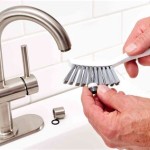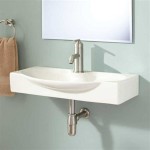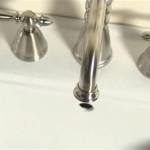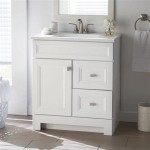Built-In Bathroom Shelf Ideas: Optimizing Space and Enhancing Aesthetics
Built-in bathroom shelves represent a significant design element that transcends mere storage functionality. They become integral components of the bathroom's architecture, contributing to both its practicality and visual appeal. Integrating shelves directly into the wall structure or cabinetry offers a streamlined and cohesive look, maximizing space utilization while minimizing visual clutter. The following discussion explores various built-in bathroom shelf ideas, considering materials, design styles, and practical considerations for implementation.
The selection of built-in shelving often hinges on the overall aesthetic intended for the bathroom. Modern designs favor minimalist approaches with clean lines and geometric shapes, whereas traditional themes may incorporate ornate details and classic materials. The available space, budget constraints, and existing plumbing and electrical infrastructure also influence the feasibility and design of the built-in shelving project.
Planning and Design Considerations for Built-In Bathroom Shelves
Before commencing any built-in shelving project, careful planning and design are crucial. This phase involves assessing the specific storage needs, evaluating the available space, and considering potential design variations. A detailed plan ensures the shelves are not only aesthetically pleasing but also functionally effective.
Firstly, determine the primary purpose of the shelves. Will they primarily house toiletries, towels, decorative items, or a combination thereof? Understanding the intended use dictates the necessary shelf depth, height, and weight-bearing capacity. For instance, shelves intended for storing heavy towels will require more robust construction than those designed for lightweight decorative objects.
Secondly, thoroughly evaluate the available space. Measure the wall dimensions accurately, noting any architectural constraints, such as pipes, electrical wiring, or structural supports. Factor in clearances for doors, drawers, and other bathroom fixtures to ensure the shelves do not impede movement or access. It is also vital to consider the placement of mirrors and lighting fixtures, as these elements can significantly influence the perceived size and ambiance of the space.
Thirdly, explore different design options and materials appropriate for the bathroom environment. Consider the overall style of the bathroom and select materials and finishes that complement the existing décor. Options include solid wood, engineered wood, glass, tile, and stone. Each material offers unique aesthetic properties and varying degrees of moisture resistance. For example, solid wood provides a warm and natural look but requires proper sealing to prevent water damage. Glass shelves offer a sleek and contemporary appearance but may require more frequent cleaning. Choosing the right material depends on the desired aesthetic and the level of maintenance one is willing to undertake.
Finally, create detailed drawings or sketches of the proposed shelving design. These visual representations should include precise dimensions, material specifications, and installation details. If necessary, consult with a professional designer or contractor to ensure the design is structurally sound and complies with local building codes.
Types and Styles of Built-In Bathroom Shelves
The diversity of built-in bathroom shelf designs caters to various tastes and spatial configurations. From recessed niches to floating shelves and integrated cabinetry, the options abound. The selection of a specific type depends on the architectural features of the bathroom, the available space, and the desired aesthetic.
Recessed niches, also known as alcoves, are a popular choice for shower areas and spaces adjacent to the bathtub. These shelves are built directly into the wall cavity, providing seamless storage that blends seamlessly with the surrounding surfaces. Recessed niches can be customized in terms of size, shape, and depth, allowing for the storage of shampoos, soaps, conditioners, and other bath essentials. The interior surfaces of the niches can be tiled to match the surrounding shower walls, creating a cohesive and visually appealing look.
Floating shelves offer a minimalist and contemporary design aesthetic. These shelves appear to "float" on the wall, without visible brackets or supports. They are typically mounted using concealed hardware that is embedded within the wall structure. Floating shelves are ideal for displaying decorative items, plants, or small stacks of towels. They can be arranged individually or in groups, creating a visually dynamic and customizable storage solution.
Integrated cabinetry provides a more comprehensive storage solution that combines shelving with drawers and cabinets. This type of design is particularly suitable for larger bathrooms where ample storage space is required. Integrated cabinetry can be customized to fit specific needs, incorporating features such as pull-out shelves, adjustable dividers, and integrated lighting. The exterior surfaces of the cabinetry can be finished to match the vanity or other bathroom furniture, creating a cohesive and coordinated look.
Corner shelves are specifically designed for utilizing the often-overlooked corner spaces in the bathroom. These shelves can be either floating or supported by brackets and are ideal for storing small items such as toiletries, decorative objects, or plants. Corner shelves can be arranged individually or in tiers, maximizing vertical storage space.
Above-toilet shelves offer a practical solution for maximizing vertical space in smaller bathrooms. These shelves are typically installed above the toilet tank and can be used to store towels, toilet paper, or decorative items. Above-toilet shelves can be either floating or supported by brackets and can be customized in terms of size, shape, and material.
Materials and Construction Techniques for Durable Bathroom Shelves
The selection of appropriate materials and construction techniques is paramount for ensuring the longevity and durability of built-in bathroom shelves. The humid and moisture-prone environment of the bathroom necessitates the use of materials that are resistant to water damage, mold growth, and warping. Similarly, proper construction techniques are crucial for ensuring the shelves are structurally sound and can withstand the intended weight load.
Solid wood, while aesthetically pleasing, requires careful consideration due to its susceptibility to moisture damage. If solid wood is chosen, it must be properly sealed with a water-resistant coating or varnish. Hardwoods such as oak, maple, and cherry are generally more durable than softwoods such as pine. Ensure the wood is kiln-dried to minimize warping and cracking.
Engineered wood products, such as plywood and medium-density fiberboard (MDF), offer a more stable and cost-effective alternative to solid wood. These materials are less prone to warping and cracking and can be finished with a variety of veneers or laminates to achieve the desired aesthetic. However, it is crucial to select engineered wood products that are specifically designed for use in humid environments. Look for products that are labeled as "moisture-resistant" or "waterproof."
Glass shelves offer a sleek and contemporary look but require careful handling during installation. Tempered glass is recommended for bathroom shelves due to its increased strength and resistance to shattering. The edges of the glass should be smooth and polished to prevent cuts. Glass shelves can be supported by brackets or mounted using concealed hardware.
Tile and stone provide a durable and water-resistant option for bathroom shelves. These materials are particularly well-suited for recessed niches and shower areas. The tiles or stones should be installed using a waterproof adhesive and grout. Consider using epoxy grout, which is highly resistant to staining and mold growth.
Regardless of the chosen material, proper construction techniques are essential for ensuring the shelves are structurally sound. Use high-quality hardware, such as screws, anchors, and brackets, that are specifically designed for the intended weight load. Ensure the shelves are securely attached to the wall studs or backing boards. If necessary, reinforce the shelves with additional supports or bracing.
Furthermore, consider incorporating adequate ventilation into the design to minimize moisture buildup. This can be achieved by providing adequate spacing between shelves or by installing a ventilation fan in the bathroom.
In summary, the design and construction of built-in bathroom shelves require careful planning and attention to detail. By considering the specific storage needs, evaluating the available space, selecting appropriate materials and construction techniques, bathroom owners can create functional and aesthetically pleasing storage solutions that enhance the overall appeal of the space.

Open Shelving Bathroom Decor Recessed Shelves Built In Storage Ins

Diy Built In Shelving For My Bathroom

25 Brilliant Bathroom Shelf Ideas And Racks For Small Spaces

Diy Built In Bathroom Shelves And Cabinet Angela Marie Made

Interior Wonderful Recessed Bathroom Shelves Throughout 25 Best Built In Shelf And Storage Ideas For

Diy Built In Shelving For My Bathroom

Built In Bathroom Shelves Design Ideas

15 Exquisite Bathrooms That Make Use Of Open Storage Decoist

15 Between The Studs Bathroom Storage Ideas For Small Spaces

A Beginner S Guide To Various Bathroom Shelves Design
Related Posts







